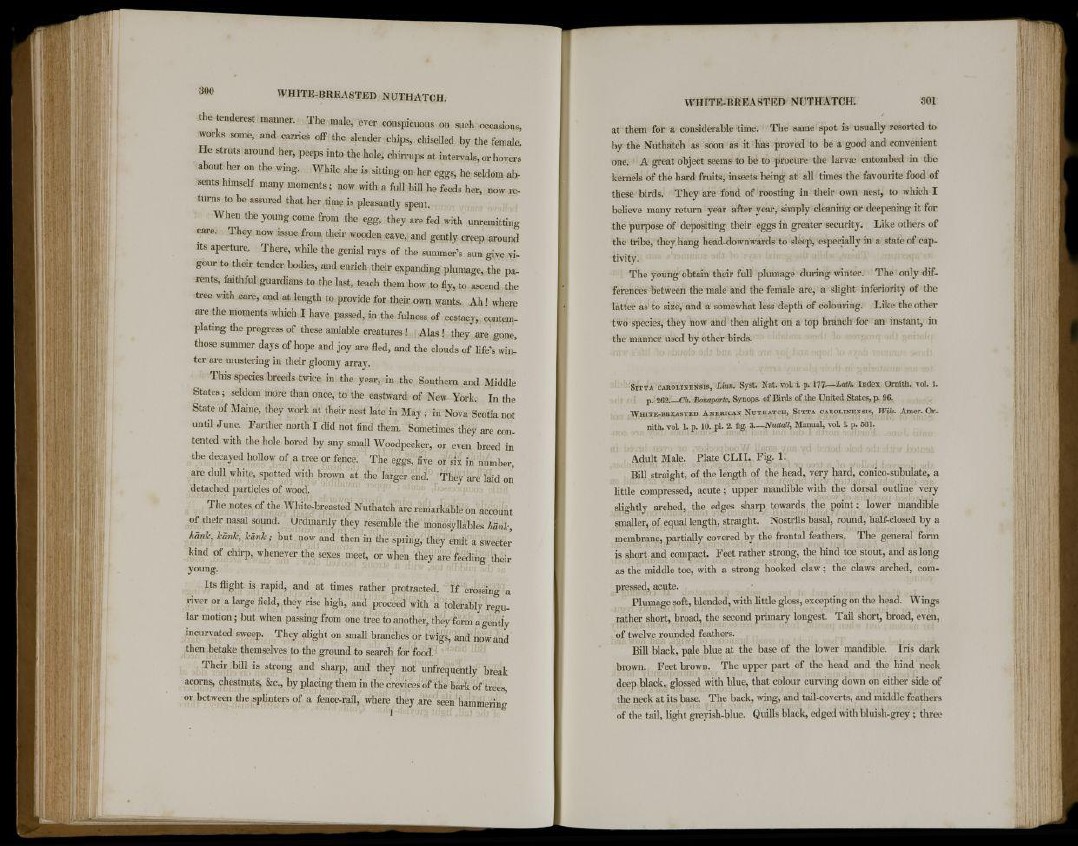
300 WHITE-BREASTED NUTHATCH.
the tenderest manner. The male, ever conspicuous on such occasions,
works some, and carries off the slender chips, chiselled by the female.
He struts around her, peeps into the hole, chirrups at intervals, or hovers
about her on the wing. While she is sitting on her eggs, he seldom absents
himself many moments ; now with a full bill he feeds her, now returns
to be assured that her time is pleasantly spent.
When the young come from the egg, they are fed with unremittingcare.
They now issue from their wooden cave, and gently creep around
its aperture. There, while the genial rays of the summer's sun give vigour
to their tender bodies, and enrich their expanding plumage, the parents,
faithful guardians to the last, teach them how to fly, to ascend the
tree with care, and at length to provide for their own wants. Ah! where
are the moments which I have passed, in the fulness of ecstacy, contemplating
the progress of these amiable creatures ! Alas ! they are gone,
those summer days of hope and joy are fled, and the clouds of life's winter
are mustering in their gloomy array.
This species breeds twice in the year, in the Southern and Middle
States; seldom more than once, to the eastward of New York. In the
State of Maine, they work at their nest late in May ; in Nova Scotia not
until June. Farther north I did not find them. Sometimes they are contented
with the hole bored by any small Woodpecker, or even breed in
the decayed hollow of a tree or fence. The eggs, five or six in number,
are dull white, spotted with brown at the larger end. They are laid on
detached particles of wood.
The notes of the White-breasted Nuthatch are remarkable on account
of their nasal sound. Ordinarily they resemble the monosyllables hank,
hank, kdnk, kank; but now and then in the spring, they emit a sweeter
kind of chirp, whenever the sexes meet, or when they are feeding their
young.
Its flight is rapid, and at times rather protracted. If crossing a
river or a large field, they rise high, and proceed with a tolerably regular
motion ; but when passing from one tree to another, they form a gently
incurvated sweep. They alight on small branches or twigs, and now and
then betake themselves to the ground to search for food.
Their bill is strong and sharp, and they not unfrequently break
acorns, chestnuts, &c, by placing them in the crevices of the bark of trees,
or between the splinters of a fence-rail, where they are seen hammering
WHITE-BREASTED NUTHATCH. 301
at them for a considerable time. The same spot is usually resorted to
by the Nuthatch as soon as it has proved to be a good and convenient
one. A great object seems to be to procure the larva? entombed in the
kernels of the hard fruits, insects being at all times the favourite food of
these birds. They are fond of roosting in their own nest, to which I
believe many return year after year, simply cleaning or deepening it for
the purpose of depositing their eggs in greater security. Like others of
the tribe, they hang head-downwards to sleep, especially in a state of captivity.
The young obtain their full plumage during winter. The only differences
between the male and the female are, a slight inferiority of the
latter as to size, and a somewhat less depth of colouring. Like the other
two species, they now and then alight on a top branch for an instant, in
the manner used by other birds.
SITTA CAROI-INENSIS, Linn. Syst. Nat. voL L p. 177«—Lath. Index Ornith. vol. i.
p. 262 Ch. Bonaparte, Synops. of Birds of the United States, p. 96.
WHITE-BREASTED AMERICAN NUTHATCH, SITTA CAROLINENSIS, Wits. Amer. Ornith.
vol. 1. p. 10. pi. 2. fig. 3—Nuttall, Manual, vol. i. p. 581.
-noa stB Ypn) sDUu&moG .moat brut jon bib I rllnoii ivdiiBr>L .otwl* Ihnu
Adult Male. Plate CLII. Fig. 1.
Bill straight, of the length of the head, very hard, conico-subulate, a
little compressed, acute; upper mandible with the dorsal outline very
slightly arched, the edges sharp towards the point; lower mandible
smaller, of equal length, straight. Nostrils basal, round, half-closed by a
membrane, partially covered by the frontal feathers. The general form
is short and compact. Feet rather strong, the hind toe stout, and as long
as the middle toe, with a strong hooked claw; the claws arched, compressed,
acute.
Plumage soft, blended, with little gloss, excepting on the head. Wings
rather short, broad, the second primary longest. Tail short, broad, even,
of twelve rounded feathers.
Bill black, pale blue at the base of the lower mandible. Iris dark
brown. Feet brown. The upper part of the head and the hind neck
deep black, glossed with blue, that colour curving down on either side of
the neck at its base. The back, wing, and tail-coverts, and middle feathers
of the tail, light greyish-blue. Quills black, edged with bluish-grey ; three